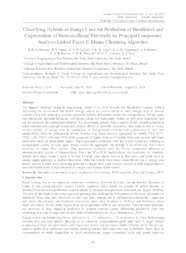Classifying hybrids of energy cane for production of bioethanol and cogeneration of biomass-based electricity by principal component analysis-linked fuzzy c-means clustering algorithm.
Classifying hybrids of energy cane for production of bioethanol and cogeneration of biomass-based electricity by principal component analysis-linked fuzzy c-means clustering algorithm.
Author(s): MOREIRA, B. R. de A.; VIANA, R. da S.; LISBOA, L. A. M.; LOPES, P. R. M.; FIGUEIREDO, P. A. M. de; RAMOS, S. B.; BONINI, C. S. B.; TRINDADE, V. D. R.; ANDRADE, M. G. de O.; MAY, A.
Summary: Abstract: The biggest challenge facing in sugar-energy plants is to move towards the biorefinery concept, without threatening the environment and health. Energy cane is the state-of-the-art of smart energy crops to provide suitable whole-raw material to produce upgraded biofuels, dehydrated alcohol for transportation, refined sugar, yeast- fermented alcoholic beverages, soft drinks, silage and high quality fodder, as well as to cogenerate heat and bioelectricity from burnt lignocellulose. We, accordingly, present fuzzy c-means (FCM) clustering algorithm interconnected with principal component analysis (PCA) as powerful exploratory data analysis tool to wisely classify hybrids of energy cane for production of first-generation ethanol and cogeneration of heat and bioelectricity. From the orthogonally-rotated factorial map, fuzzy cluster I aggregated the hybrids VX12-0277, VX12-1191, VX12-1356 and VX12-1658 composed of higher contents of soluble solids and sucrose, and larger productive yields of fermentable sugars. These parameters correlated with the X-axis component referring to technological quality of cane juice. Fuzzy cluster III aggregated the hybrids VX12-0180 and VX12-1022 consisted of higher fiber content. This parameter correlated with the Y-axis component referring to physicochemical quality of lignocellulose. From the PCA-FCM methodology, the conclusion is, therefore, hybrids from fuzzy cluster I prove to be type I energy cane (higher sucrose to fiber ratio) and could serve as energy supply pathways to produce bioethanol, while the hybrids from fuzzy cluster III are type II energy cane (lower sucrose to fiber ratio), denoting potential as higher fiber yield biomass sources to feed cogeneration of heat and bioelectricity in high temperature and pressure furnace-boiler system.
Publication year: 2019
Types of publication: Journal article
Unit: Embrapa Environment
Observation
Some of Embrapa's publications are published as ePub files. To read them, use or download one of the following free software options to your computer or mobile device. Android: Google Play Books; IOS: iBooks; Windows and Linux: Calibre.
Access other publications
Access the Agricultural Research Database (BDPA) to consult Embrapa's full library collection and records.
Visit Embrapa Bookstore to purchase books and other publications sold by Embrapa.

